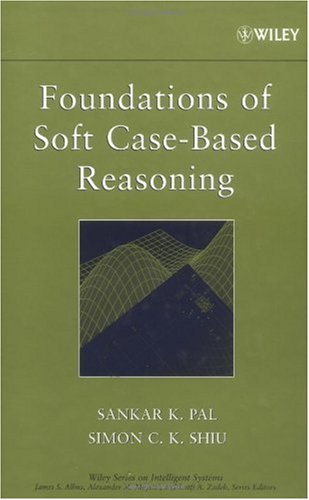Simon Shiu, Sankar K. Pal0471086355, 9780471086352
Table of contents :
Team DDU……Page 1
CONTENTS……Page 10
FOREWORD……Page 16
PREFACE……Page 20
ABOUT THE AUTHORS……Page 24
1.1 Background……Page 26
1.2 Components and Features of Case-Based Reasoning……Page 27
1.2.1 CBR System versus Rule-Based System……Page 29
1.2.2 CBR versus Human Reasoning……Page 30
1.2.3 CBR Life Cycle……Page 31
1.4 Advantages of Using Case-Based Reasoning……Page 34
1.5 Case Representation and Indexing……Page 36
1.5.1 Case Representation……Page 37
1.6 Case Retrieval……Page 40
1.7 Case Adaptation……Page 43
1.8.1 Learning in CBR Systems……Page 44
1.8.2 Case-Base Maintenance……Page 45
1.9 Example of Building a Case-Based Reasoning System……Page 46
1.9.2 Case Indexing……Page 48
1.9.3 Case Retrieval……Page 49
1.9.4 Case Adaptation……Page 50
1.10 Case-Based Reasoning: Methodology or Technology?……Page 51
1.11 Soft Case-Based Reasoning……Page 52
1.11.1 Fuzzy Logic……Page 54
1.11.4 Some CBR Tasks for Soft Computing Applications……Page 55
1.12 Summary……Page 56
References……Page 57
2.1 Introduction……Page 59
2.2 Traditional Methods of Case Representation……Page 62
2.2.1 Relational Representation……Page 63
2.2.2 Object-Oriented Representation……Page 65
2.2.3 Predicate Representation……Page 66
2.2.4 Comparison of Case Representations……Page 67
2.3.1 Case Knowledge Representation Based on Fuzzy Sets……Page 68
2.3.2 Rough Sets and Determining Reducts……Page 71
2.3.3 Prototypical Case Generation Using Reducts with Fuzzy Representation……Page 77
2.4.1 Traditional Indexing Method……Page 88
2.4.2 Case Indexing Using a Bayesian Model……Page 89
2.4.3 Case Indexing Using a Prototype-Based Neural Network……Page 94
2.4.4 Case Indexing Using a Three-Layered Back Propagation Neural Network……Page 96
2.5 Summary……Page 97
References……Page 98
3.1 Introduction……Page 100
3.2.1 Weighted Euclidean Distance……Page 101
3.2.3 Cosine Coefficient for Text-Based Cases……Page 103
3.2.4 Other Similarity Measures……Page 104
3.3 Concept of Fuzzy Sets in Measuring Similarity……Page 105
3.3.1 Relevance of Fuzzy Similarity in Case Matching……Page 106
3.3.2 Computing Fuzzy Similarity Between Cases……Page 110
3.4 Fuzzy Classification and Clustering of Cases……Page 115
3.4.1 Weighted Intracluster and Intercluster Similarity……Page 116
3.4.2 Fuzzy ID3 Algorithm for Classification……Page 117
3.4.3 Fuzzy c-Means Algorithm for Clustering……Page 121
3.5 Case Feature Weighting……Page 123
3.5.1 Using Gradient-Descent Technique and Neural Networks……Page 124
3.5.2 Using Genetic Algorithms……Page 127
3.6 Case Selection and Retrieval Using Neural Networks……Page 130
3.6.1 Methodology……Page 131
3.6.2 Glass Identification……Page 133
3.7 Case Selection Using a Neuro-Fuzzy Model……Page 134
3.7.1 Selection of Cases and Class Representation……Page 135
3.7.2 Formulation of the Network……Page 136
3.8.1 Pattern Indiscernibility and Fuzzy Discretization of Feature Space……Page 145
3.8.2 Methodology for Generation of Reducts……Page 146
3.8.3 Rough SOM……Page 147
3.8.4 Experimental Results……Page 149
3.9 Summary……Page 155
References……Page 156
4.1 Introduction……Page 161
4.2 Traditional Case Adaptation Strategies……Page 162
4.2.1 Reinstantiation……Page 163
4.2.2 Substitution……Page 164
4.2.3 Transformation……Page 167
4.3 Some Case Adaptation Methods……Page 168
4.3.1 Learning Adaptation Cases……Page 173
4.3.3 Using an Adaptation Matrix……Page 174
4.4 Case Adaptation Through Machine Learning……Page 175
4.4.1 Fuzzy Decision Tree……Page 176
4.4.2 Back-Propagation Neural Network……Page 177
4.4.3 Bayesian Model……Page 178
4.4.4 Support Vector Machine……Page 179
4.4.5 Genetic Algorithms……Page 183
References……Page 184
5.1 Introduction……Page 186
5.2 Background……Page 187
5.3.1 Qualitative Maintenance……Page 188
5.3.2 Quantitative Maintenance……Page 190
5.4 Case-Base Maintenance Using a Rough-Fuzzy Approach……Page 191
5.4.1 Maintaining the Client Case Base……Page 192
5.4.2 Experimental Results……Page 207
5.4.3 Complexity Issues……Page 211
5.5 Case-Base Maintenance Using a Fuzzy Integral Approach……Page 212
5.5.1 Fuzzy Measures and Fuzzy Integrals……Page 213
5.5.2 Case-Base Competence……Page 215
5.5.3 Fuzzy Integral¨CBased Competence Model……Page 217
5.5.4 Experiment Results……Page 220
References……Page 221
6.1 Introduction……Page 226
6.2.1 Case Representation Using Fuzzy Sets……Page 227
6.2.2 Mining Fuzzy Association Rules……Page 228
6.3.1 System Architecture……Page 230
6.3.2 Case Retrieval Using a Fuzzy Neural Network……Page 231
6.3.3 Case Evaluation and Adaptation Using Induction……Page 232
6.4.2 Case Adaptation Using ANN……Page 234
6.5.1 Fuzzy Logic in Case Representation……Page 238
6.5.2 Fuzzy Similarity in Case Retrieval and Inference……Page 240
6.6.1 PROFIT System……Page 241
6.6.2 Fuzzy Preference in Case Retrieval……Page 242
6.7.1 Structure of a Hybrid CBR System Using GAs……Page 244
6.7.2 GA in Case Indexing and Retrieval……Page 245
6.8.1 Structure of the Color-Matching Process……Page 246
6.8.2 Fuzzy Case Retrieval……Page 247
6.9 Shoe Design……Page 248
6.9.1 Feature Representation……Page 249
6.9.2 Neural Networks in Retrieval……Page 250
6.11 Summary……Page 251
References……Page 252
APPENDIXES……Page 254
A FUZZY LOGIC……Page 256
A.1 Fuzzy Subsets……Page 257
A.2 Membership Functions……Page 259
A.4 Measure of Fuzziness……Page 261
A.5 Fuzzy Rules……Page 262
A.5.2 Fuzzy Rules for Classification……Page 263
References……Page 265
B ARTIFICIAL NEURAL NETWORKS……Page 267
B.1 Architecture of Artificial Neural Networks……Page 268
B.2 Training of Artificial Neural Networks……Page 269
B.3.1 Single-Layered Perceptron……Page 271
B.3.2 Multilayered Perceptron Using a Back-Propagation Algorithm……Page 272
B.3.3 Radial Basis Function Network……Page 274
B.3.4 Kohonen Neural Network……Page 276
References……Page 277
C.1 Basic Principles……Page 278
C.2 Standard Genetic Algorithm……Page 279
C.3.1 Function Maximization……Page 281
C.3.2 Traveling Salesman Problem……Page 284
References……Page 285
D.1 Information Systems……Page 287
D.2 Indiscernibility Relation……Page 289
D.3 Set Approximations……Page 290
D.4 Rough Membership……Page 291
D.5 Dependency of Attributes……Page 292
References……Page 293
INDEX……Page 296







Reviews
There are no reviews yet.